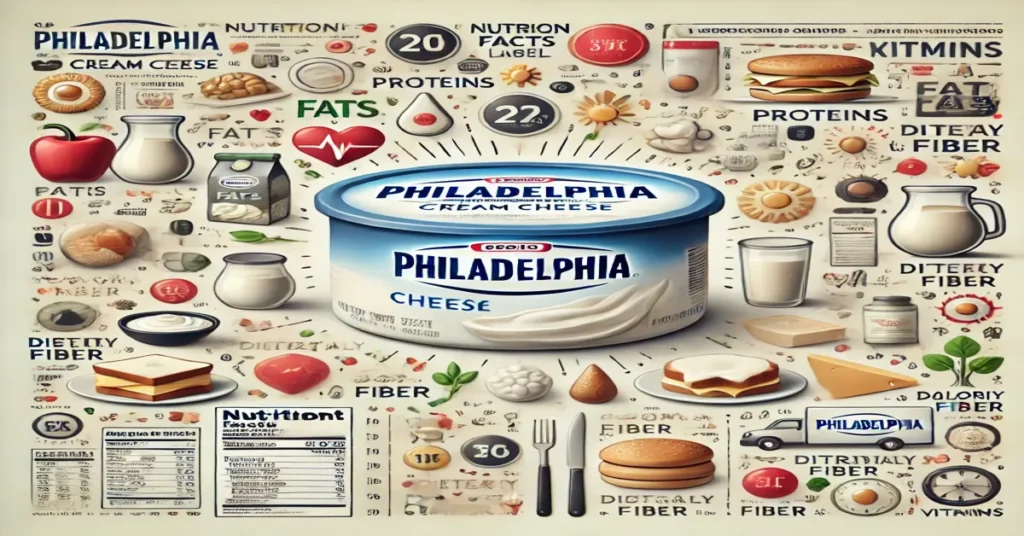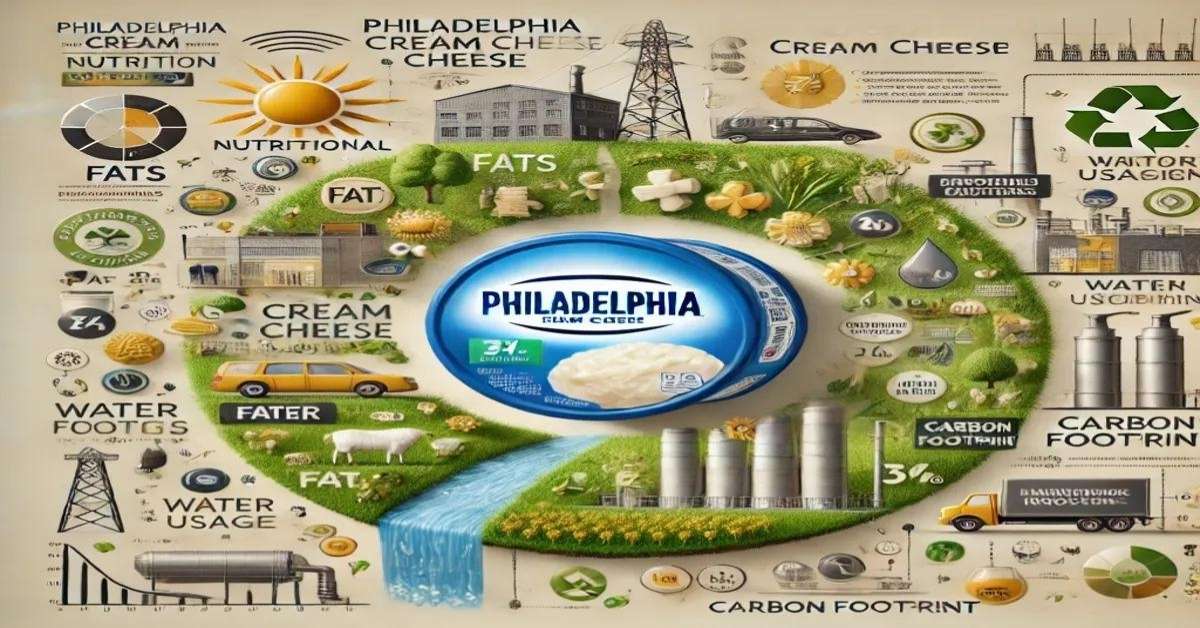Introduction
Philadelphia cream cheese is a beloved dairy product used in both sweet and savory dishes worldwide. Its creamy texture and mild flavor make it a versatile ingredient in various cuisines, but beyond its taste, it’s important to understand the Philadelphia cream cheese nutrition profile. As consumers become more conscious of their food choices, exploring the nutritional aspects of this popular dairy spread, along with the environmental implications of its production, is crucial.
In this article, we will examine the Philadelphia cream cheese nutrition facts, focusing on its macronutrients, vitamins, and minerals, as well as potential health benefits and concerns. Additionally, we will discuss the environmental impact of cream cheese production, touching on dairy farming practices, energy use, packaging, and distribution. By understanding both the nutritional and environmental aspects of Philadelphia cream cheese nutrition, consumers can make informed decisions that balance health with sustainability.
1. Nutritional Profile of Philadelphia Cream Cheese
The Philadelphia cream cheese nutrition profile reveals that this popular dairy product is rich in fats and proteins, with moderate caloric density. While it can fit into a balanced diet, understanding its macronutrient and micronutrient content is essential for those mindful of their daily intake.

1.1. Macronutrients
The macronutrient composition of Philadelphia cream cheese nutrition primarily consists of fats and proteins, with minimal carbohydrates.
- Calories: A 1 oz (28 grams) serving of Philadelphia cream cheese contains around 100 calories, making it a calorie-dense food. The calorie content is mostly derived from fat, which contributes to the rich, creamy texture.
- Fats: The Philadelphia cream cheese nutrition facts indicate that one serving contains about 9 grams of fat, with 5.5 grams being saturated fats. Fats are vital for energy, but too much saturated fat can pose cardiovascular health risks.
- Proteins: Each serving provides 2 grams of protein, which contributes to muscle maintenance and tissue repair. While not a high-protein food, it still adds to the overall daily protein intake.
- Carbohydrates: Cream cheese is low in carbs, with just 1 gram per serving. This makes Philadelphia cream cheese nutrition suitable for low-carb and ketogenic diets.
1.2. Vitamins and Minerals
The Philadelphia cream cheese nutrition profile also includes various vitamins and minerals, though the amounts may not be as significant compared to other dairy products.
- Calcium: Like most dairy products, Philadelphia cream cheese contains calcium. A serving provides around 3-5% of the daily recommended intake, supporting bone health and muscle function.
- Vitamin A: The Philadelphia cream cheese nutrition facts show that a serving provides about 10% of the daily value of vitamin A, which is crucial for vision, skin health, and immune function.
- Sodium: A serving contains approximately 90 mg of sodium, which can add up for individuals monitoring their salt intake. While not excessively high, the sodium in Philadelphia cream cheese nutrition should be considered as part of the overall diet.
- Other Micronutrients: Small amounts of vitamin D, riboflavin, and phosphorus are also present, but they are not significant contributors to the daily intake.
2. Health Implications of Philadelphia Cream Cheese Nutrition
While Philadelphia cream cheese nutrition offers a tasty and creamy addition to many dishes, it’s important to balance its consumption with other healthier foods. The high fat and sodium content can have implications for certain individuals, especially those with specific dietary needs or health concerns.

2.1. Benefits of Philadelphia Cream Cheese Nutrition in Moderation
When enjoyed in moderation, the Philadelphia cream cheese nutrition profile can provide certain health benefits.
- Healthy Fats: Although rich in saturated fats, Philadelphia cream cheese also provides some monounsaturated fats, which are known to support heart health when consumed as part of a balanced diet.
- Protein Intake: While it’s not a high-protein food, the protein in Philadelphia cream cheese nutrition can still contribute to the overall daily intake, especially when paired with protein-rich foods like nuts or eggs.
2.2. Potential Health Concerns
Excessive consumption of Philadelphia cream cheese nutrition could raise health concerns, particularly due to its fat content and sodium levels.
- Saturated Fat: The high saturated fat content in Philadelphia cream cheese nutrition could contribute to elevated cholesterol levels, increasing the risk of heart disease. Those with cardiovascular conditions should consider limiting their intake of cream cheese.
- Sodium Intake: The sodium content in Philadelphia cream cheese nutrition can add up, especially for individuals who consume processed foods regularly. Excess sodium is linked to high blood pressure, a risk factor for stroke and heart disease.
3. Environmental Impact of Philadelphia Cream Cheese Production
Beyond the nutritional value, it’s important to understand the environmental impact of producing a product like Philadelphia cream cheese. The dairy industry contributes to greenhouse gas emissions, water usage, and plastic waste, all of which are factors to consider when evaluating the sustainability of Philadelphia cream cheese nutrition.

3.1. Dairy Farming and Greenhouse Gas Emissions
The dairy industry is a significant contributor to greenhouse gas emissions, particularly methane, a potent gas that contributes to climate change. Methane is produced during the digestive process of cows, a key factor in the environmental footprint of Philadelphia cream cheese nutrition.
- Methane Emissions: Dairy cows release methane through enteric fermentation, and managing these emissions is a key challenge for reducing the environmental impact of dairy farming.
- Feed and Land Use: Growing feed crops like soy and corn for dairy cows requires large amounts of land and resources. Deforestation to make way for agricultural land can contribute to biodiversity loss and increased carbon emissions.
3.2. Water Use in Dairy Farming
The water footprint of dairy farming is another concern related to Philadelphia cream cheese nutrition. Dairy farms require significant amounts of water to maintain the cows and grow feed crops.
- Water for Cows: Dairy cows need large amounts of water for drinking, and additional water is used for cleaning barns and milking equipment. Water scarcity in certain regions exacerbates the environmental impact of Philadelphia cream cheese nutrition.
- Irrigation of Crops: The feed crops for dairy cows often require irrigation, which further adds to the water footprint. Sustainable farming practices, such as using recycled water and efficient irrigation methods, can help mitigate these impacts.
3.3. Packaging and Waste
The packaging used for Philadelphia cream cheese nutrition has its own environmental impact, particularly in the form of plastic waste. The plastic tubs or foil-wrapped blocks contribute to the overall environmental footprint of the product.
- Plastic Packaging: Non-recyclable plastic packaging for Philadelphia cream cheese nutrition can end up in landfills or oceans, contributing to plastic pollution.
- Sustainable Packaging Initiatives: Some companies are exploring more eco-friendly packaging alternatives, such as biodegradable materials or recycled plastic, which could reduce the environmental impact of cream cheese packaging.
4. Sustainable Alternatives and Consumer Choices
As consumers become more conscious of both nutrition and environmental impact, sustainable and ethical choices for Philadelphia cream cheese nutrition are emerging. From organic dairy to plant-based alternatives, there are options for reducing the environmental footprint while still enjoying the creamy texture and flavor of cream cheese.

4.1. Organic and Grass-Fed Dairy
Choosing organic or grass-fed dairy products can reduce the environmental impact of Philadelphia cream cheese nutrition by promoting more sustainable farming practices.
- Organic Dairy: Organic dairy farming avoids synthetic pesticides and fertilizers, promoting healthier soil and ecosystems. Organic farming practices can reduce the environmental burden associated with Philadelphia cream cheese nutrition.
- Grass-Fed Dairy: Grass-fed cows primarily eat pasture, which can help reduce the need for grain-based feed and promote healthier soil. Grass-fed dairy products may have a smaller environmental footprint and offer a more sustainable option for Philadelphia cream cheese nutrition.
4.2. Plant-Based Cream Cheese Alternatives
For those looking to reduce their reliance on dairy, plant-based cream cheese alternatives offer a more environmentally friendly option. Made from ingredients like nuts, soy, or coconut, these alternatives have a lower environmental footprint than traditional dairy-based products.
- Lower Greenhouse Gas Emissions: Plant-based alternatives to Philadelphia cream cheese nutrition typically require fewer resources and produce fewer emissions than dairy production.
- Nutritional Comparison: While plant-based cream cheese alternatives may differ in texture and flavor, many provide healthy fats and proteins. However, consumers should check for added sugars and preservatives in these alternatives.
4.3. Reducing Food Waste
One of the simplest ways to reduce the environmental impact of Philadelphia cream cheese nutrition is to avoid food waste. Proper storage and portioning can help extend the shelf life of cream cheese, minimizing waste.
- Proper Storage: Store Philadelphia cream cheese nutrition in the refrigerator at the recommended temperature to maintain freshness. Keeping the product sealed helps prevent spoilage.
- Creative Uses: Incorporating cream cheese into multiple dishes ensures that none goes to waste. From dips and spreads to sauces and desserts, there are many ways to use Philadelphia cream cheese nutrition.
Conclusion: Balancing Philadelphia Cream Cheese Nutrition with Sustainability
Philadelphia cream cheese offers a rich, creamy addition to countless dishes, but it’s important to balance its nutritional content with environmental considerations. By understanding the Philadelphia cream cheese nutrition facts and the impact of its production, consumers can make informed choices that contribute to both personal health and environmental sustainability.
From choosing organic and grass-fed options to reducing food waste and exploring plant-based alternatives, there are many ways to enjoy Philadelphia cream cheese nutrition while minimizing its environmental footprint.
Read More: Butte Valley National: An Exploration of Ecological Significance and Conservation Efforts

